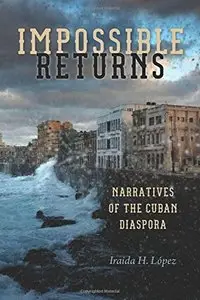Impossible Returns: Narratives of the Cuban Diaspora by Iraida H. Lopez
2015 | ISBN: 0813061032 | English | 312 pages | PDF | 3 MB
2015 | ISBN: 0813061032 | English | 312 pages | PDF | 3 MB
“Soulfully researched and elegantly written, the personal and the critical converge into a reading of Cuban American memoirs by ‘one-and-a-halfers,’ those in a generation who left the island in childhood and early adolescence.”—Eliana S. Rivero, author of Discursos desde la diáspora
“Timely and salient. In addition to tracing the trajectory of narratives of return, this study puts into relief the idea that there is no singular process of return.”—Andrea O’Reilly Herrera, author of Cuban Artists across the Diaspora: Setting the Tent against the House
“Outstanding. López’s interpretation of the narratives of the émigré’s real or imagined returns to their homeland is insightful, sensitive, well documented, and informed by current debates about diasporas, exile, transnationalism, and identity.”—Jorge Duany, author of Blurred Borders: Transnational Migration between the Hispanic Caribbean and the United States
While the stories and resettlement patterns of Cubans who have left their home island have been widely documented, the subject of return in the Cuban diaspora remains understudied.
In this one-of-a-kind volume, Iraida López explores various narratives of return by those who left Cuba as children or adolescents. Including memoirs, semi-autobiographical fiction, and visual arts, many of these accounts feature a physical arrival on the island while others depict a metaphorical or vicarious experience by means of fictional characters or childhood reminiscences. As two-way migration increases in the post-Cold War period, many of these narratives put to the test the boundaries of national identity.
Through a critical reading of works by Cuban American artists and writers like María Brito, Ruth Behar, Carlos Eire, Cristina García, Ana Mendieta, Gustavo Pérez Firmat, Ernesto Pujol, Achy Obejas, and Ana Menéndez, López highlights the affective ties as well as the tensions underlying the relationship between returning subjects and their native country. Impossible Returns also looks at how Cubans still living on the island depict returning émigrés in their own narratives, addressing works by Jesús Díaz, Humberto Solás, Carlos Acosta, Nancy Alonso, Leonardo Padura, and others. Blurring the lines between disciplines and geographic borders, this book underscores the centrality of Cuba for its diaspora and bears implications for other countries with widespread populations in exile.



